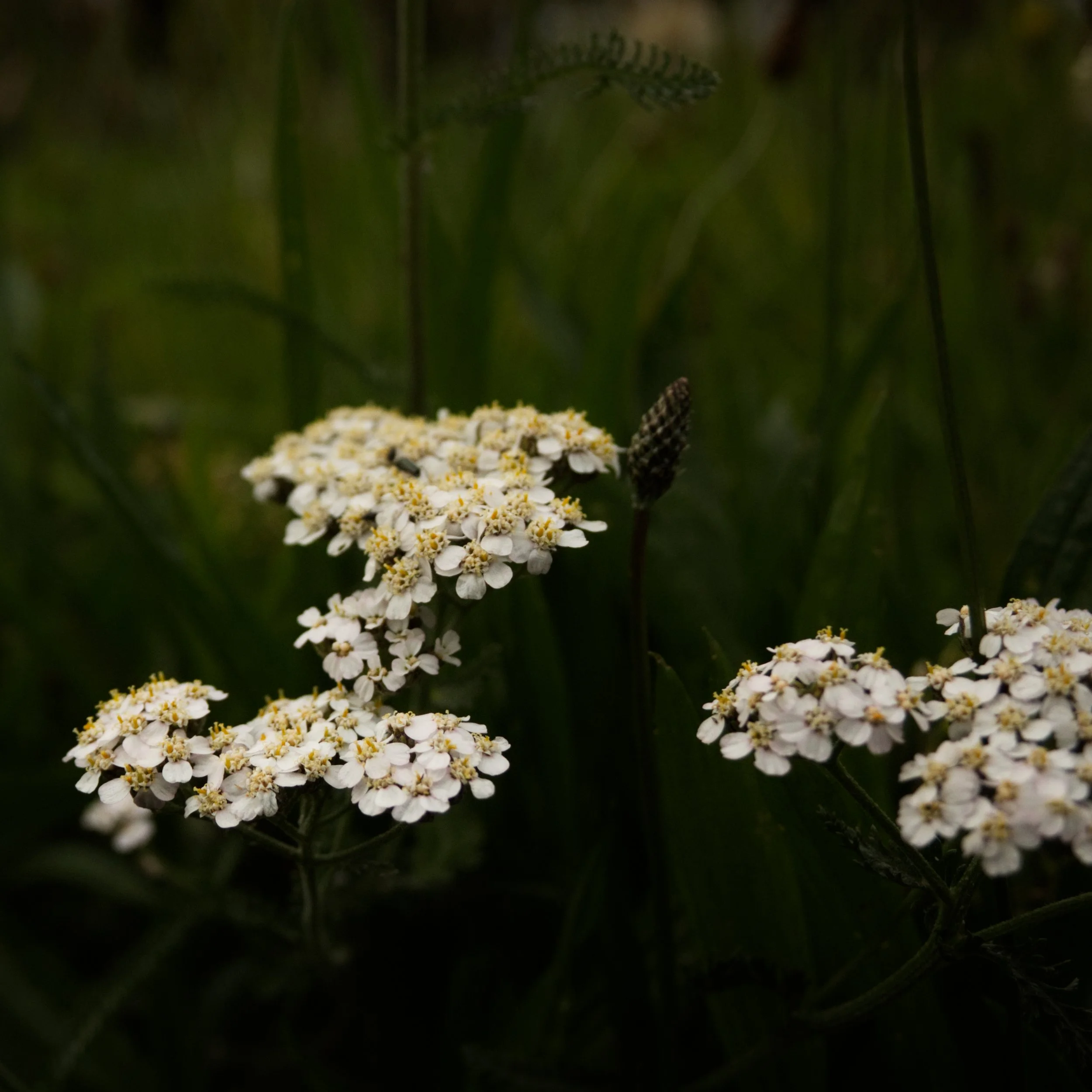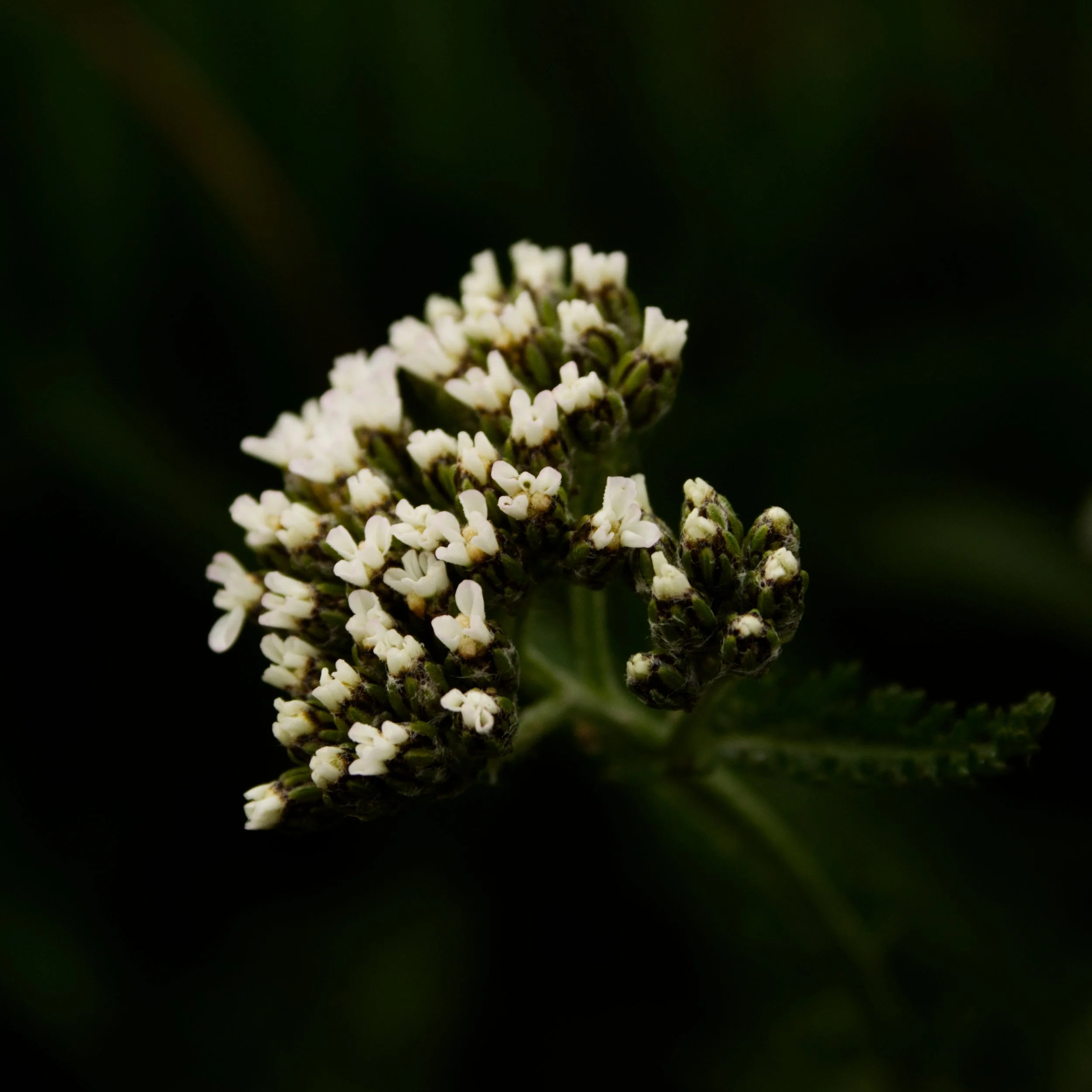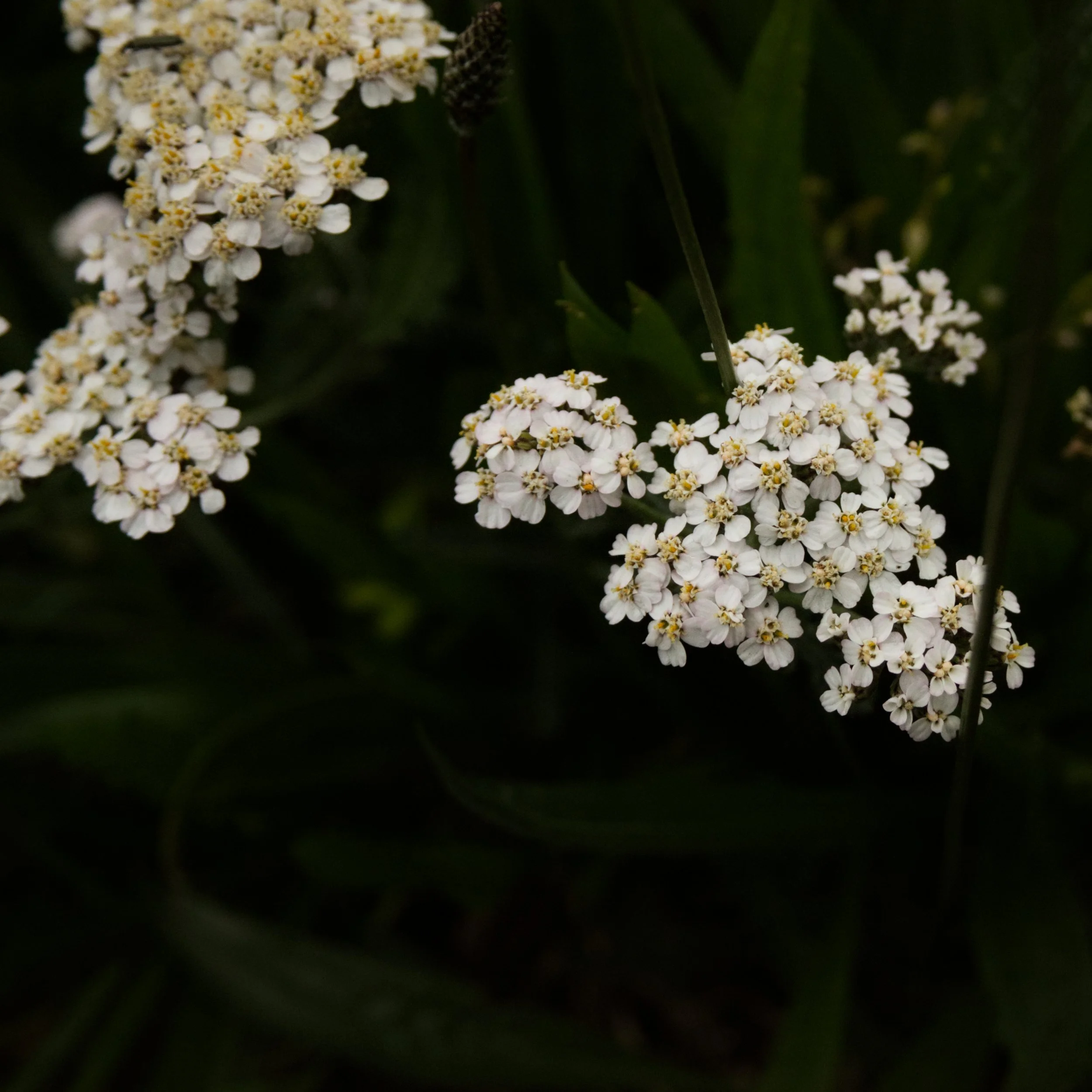Boy's Love and The Death Flower
Welsh common names: Milddail, Gwilffrai, Llysiau Gwaedlif, Llysiau Marwolaeth, Milfyd, Minfel, Wrisgan Llwyd
English common names: Yarrow, Milfoil
Scientific name: Achillea Millefolium
Low-lying in the undergrowth, the basal leaves sprout like a starfish; soft and nimble feelers that creep through the grass. A central stem emerges, and at the tip, knots of silvery buds open out into strongly scented, flat clusters of pale-pink to white florets.
Yarrow can be seen in meadows, lawns and verges from early spring to mid autumn, growing up to 50cm tall. The flower clusters might look similar to umbellifers such as cow parsley or poisonous hemlock, but yarrow is smaller in stature with distinctive feathery leaves, inspiring descriptive names such as the English milfoil, the latin milefolium, and the Welsh milddail; all meaning ‘a thousand leaves’.
The plant’s additional Welsh name llysiau gwaedlif, translates to ‘blood-flow’ or ‘haemorrhage plant’, referring to yarrow’s long-observed effects on blood. The herb has styptic, anti-inflammatory, astringent and antiseptic actions, and a poultice made from crushed leaves can be applied to cuts and grazes to staunch blood flow, as reflected in numerous English names such as woundwort, staunch-weed, and even the charming hemmin’ and sewin’; likely referring to the herb’s usefulness for pin pricks.
If taken internally, yarrow has a normalising, dual effect on the circulatory system by promoting blood flow where needed, and suppressing excessive blood loss elsewhere. This has made it an especially important plant for women and those who menstruate, as it can regulate menstrual flow and promote the movement of stagnated blood, making it beneficial for both heavy and scanty periods, as well as easing period pain and cramps. Consuming yarrow can also improve the strength and flexibility of blood vessels, as well as encouraging blood flow to the peripherals, potentially reducing blood pressure.
An ancient would herb, the scientific name Achillea derives from Achilles, the hero of the Trojan War in Greek mythology. According to ancient physician Dioscorides, Achilles discovered yarrow and learned of its ability to heal wounds inflicted by iron weapons.
The Welsh Medieval Physicians of Myddfai list yarrow as a remedy for many ailments, including breaking a fever, ‘strange vomiting’, and stopping a nosebleed:
‘pound the milfoil with vinegar in a mortar. Plug the nostrils therewith, and it will stay the bleeding'
Peleus entrusting his son Achilles to the care of the centaur Chiron, who is holding a plant that resembles yarrow. Image source: Wikimedia commons.
In folklore, yarrow is commonly associated with with love divination and many curious customs from all over the British Isles, feature young ‘maids’ employing the plant in a variety of ways to foretell who they might marry.
In Herefordshire, a woman had to pick yarrow from a churchyard she’d never before visited, wrap the plant in flannel and place it under her pillow while reciting:
Thou pretty herb of Venus tree,
Thy true name is Yarrow
Now who my bosom friend must be
Pray tell thou me tomorrow.
The next morning she would cut through the stem (which is less than a centimetre thick), and the initials of her future husband would somehow be visible inside.
Alternatively, on the eve of 30th of April in Country Donegal, youths would cut a square sod featuring yarrow, place the whole thing under their pillow, and - making sure to remain completely silent until they fell asleep - would see the face of their future love in their dreams.
As yarrow was also known as Boy’s love in Wales, there were likely similar expectations of herb-induced romantic visions in Cymru, however, in the counties of Glamorgan and Carmarthen, the plant was known as The Death Flower, and was regarded with utmost suspicion. If brought into a house it was considered a ‘certain sign of death’, and even if just the scent of yarrow was detected indoors - regardless of whether or not a plant was nearby - it was considered a ‘sure sign’ of an untimely ending.
Why this was the case in these two counties in Wales is intriguing considering the romantic associations and numerous healing qualities of the plant, which would have undoubtedly been important amongst country healers and herbalists, especially women facing the challenge of managing periods prior to the twentieth century.
Elsewhere in the UK, yarrow was also considered capable of inducing sickness and was associated with evil; additional common names being fever-plant, mother-die, devil’s nettle, and - my favourite - badman’s plaything. Holding yarrow in front of the eyes was believed to give second sight, and there is a grisly account of an Orkney resident in 1616, Elspeth Reoch, who was accused of witchcraft and supposedly used ‘Merefow’ flowers (yarrow) as part of her magic, and subsequently suffered a gruesome death at the hands of tyrannical witch hunters.
Once you know what you’re looking for, yarrow is easy to identify. The leaves and flowers can be gathered for medicinal purposes and are easily brewed into tea, or a tincture can be made by infusing the plant in vinegar/alcohol to preserve during winter months. The fresh leaves can also be added to salads.
Starlings are known to use yarrow leaves to line their nests and research indicates this could reduce the presence of parasites. The flowers are also loved by pollinators and the plant is a food source for a multitude of insects, including many species of moths. Yarrow has a deep root system and is used to improve soil quality and reduce erosion. The herb is also a natural dye-plant, producing hues from brown to pale green and yellow.
Disclaimer: don’t consume or use wild plants for health purposes without speaking to a medical professional first. Be cautious if foraging and only gather plants that you are certain of. These essays are intended to pique interest rather than act as a robust edible or medicinal guide.
Photos by Esther Williams, taken on Lower Quay Road in Hook, Pembrokeshire.
References:
Flowers and Fables: A Welsh Herbal by Jocelyn Lawton
The Handmade Apothecary: Healing Herbal Remedies by Vicky Chown and Kim Walker
Vickery’s Folk Flora by Roy Vickery
Welsh Names of Plants by Dafydd Davies and Arthur Jones
https://witches.hca.ed.ac.uk/case/C/EGD/2212
https://nsojournals.onlinelibrary.wiley.com/doi/epdf/10.1111/j.2007.0908-8857.04015.x
https://www.botanical.com/botanical/mgmh/y/yarrow02.html
https://archive.org/stream/physiciansmyddv00willgoog/physiciansmyddv00willgoog_djvu.txt
https://www.wildlifetrusts.org/wildlife-explorer/wildflowers/yarrow
https://geiriaduracademi.org/?lang=en
https://geiriadur.ac.uk/gpc/gpc.html






